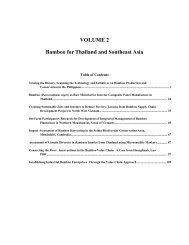WBC-VIII-Vol.4 – Resources – Forestry, Plantations and ... - BambuSC
WBC-VIII-Vol.4 – Resources – Forestry, Plantations and ... - BambuSC
WBC-VIII-Vol.4 – Resources – Forestry, Plantations and ... - BambuSC
Create successful ePaper yourself
Turn your PDF publications into a flip-book with our unique Google optimized e-Paper software.
Lei Bamboo (Phyllostachys praecox) Growth Degradation<br />
associated with Soil Properties using an Organic Material<br />
Mulching Technique<br />
1 Renyi Gui, 2* Shunyao Zhuang, 1 Guodong Li, 3 Yongjun Zhu<br />
1 Bamboo Research Institute, Zhejiang <strong>Forestry</strong> University, Lin-an, China<br />
2 State Key Lab of Soil <strong>and</strong> Sustainable Agriculture, Institute of Soil Sciences,<br />
Chinese Academy of Sciences, Nanjing, China<br />
3 Lin-an <strong>Forestry</strong> Bureau, Lin’an, Zhejiang Province, China<br />
*Corresponding author, SY Zhuang, State Key Lab of Soil <strong>and</strong> Sustainable Agriculture, Institute of Soil<br />
Science, Chinese Academy of Sciences, Nanjing, China.<br />
Abstract<br />
In the last 20 years, Lei bamboo (Phyllostachys praecox) has been extensively planted on former paddy soils for<br />
its high economic profit in Southeast China. However, Lei bamboo showed a significant degradation in growth<br />
after several years with an organic material mulching technique. Based on the inquiry of the farmers, we<br />
speculated that soil basic properties changed with the intensive management may be responsible for the bamboo<br />
degradation. Accordingly, an investigation of soil basic properties with the bamboo plantation was made in<br />
detail. A series of bamboo soils with various planting times was chosen to analyze the soil basic properties.<br />
Results showed that soil pH values decreased significantly from 5.71 to 3.85 with increasing planting time,<br />
while soil organic C, total N <strong>and</strong> P increased dramatically. At the same time, soil active Al which is toxic to<br />
plant growth increased dramatically from 3.85 to 197.6 mg kg -1 after 15 years of the bamboo plantation. High Al<br />
content was found in the degraded bamboo roots that verified the hypothesis that the intensive management<br />
made soil nutrients available imbalance <strong>and</strong> lowered the soil pH greatly that possibly resulted in the bamboo<br />
growth impairment. Therefore, the present practice of bamboo management had a great influence on soil quality<br />
that affected the bamboo sustainable production. A better or improved practice should be used in the future of<br />
the bamboo production.<br />
Keywords: aluminum, bamboo, intensive management, soil properties<br />
Introduction<br />
Lei bamboo (Phyllostachys praecox) is a famous kind of bamboos for shoot food production in China. This<br />
bamboo has advantages in early shoot supply, long time of shoot production, high yield <strong>and</strong> delicious taste after<br />
tamed from the local nature species. Lei bamboo mainly distributes in the counties of De-qing, Yu-hang <strong>and</strong><br />
Lin-an of Zhejiang Province, Southeast China. Since from 1990, the bamboo plantation has been obtained a<br />
great economic benefit using an organic material mulching technique to increase soil temperature <strong>and</strong> supply<br />
<strong>VIII</strong> World Bamboo Congress Proceedings Vol 4-57




